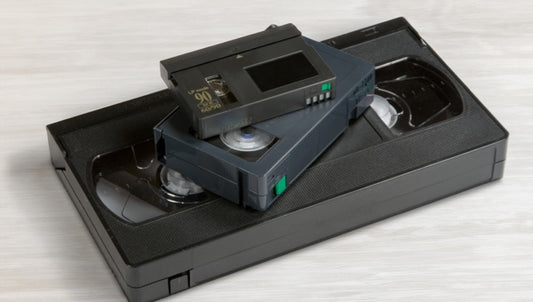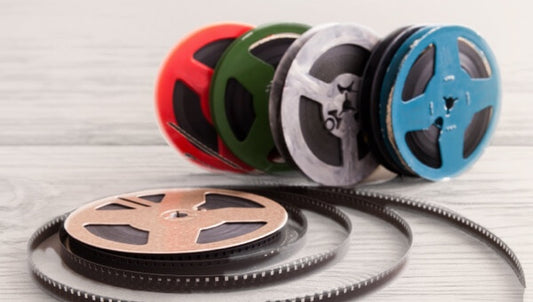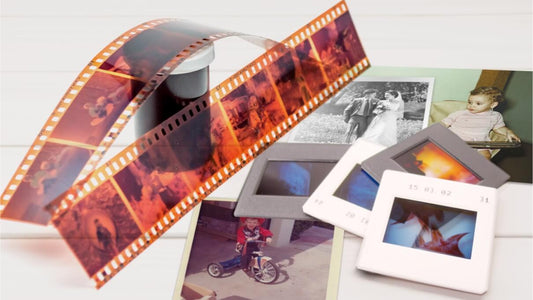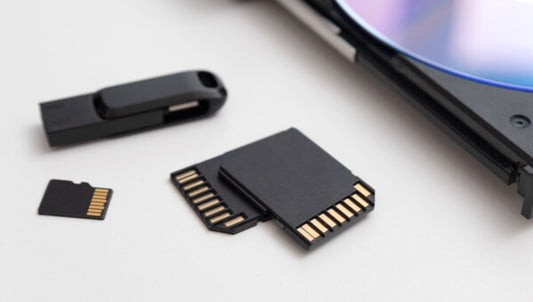In the late 1970s, there was a videotape format war and while VHS tapes ended up being the winner, Betamax remained a fairly popular home video format for around 20 years. But what is Betamax, how does it work, and what makes it different from other video cassette formats?
For over 20 years, Capture has been one of the top choices for preserving home movies including Betamax and VHS. Whether you want to learn more about your old Betamax machines and videos or want to try to use analog videotapes for new memories, we put together this guide with all the information you need.
Keep reading to learn about the rise of Betamax, the format war, certain features of Beta tapes, a landmark legal case involving Betamax, and interesting little-known facts about the Betamax legacy.
Jump to:
- What is Betamax?
- The Rise of Betamax
- The Format War: Betamax vs. VHS
- Betamax Features and Limitations
- The Legal Battle and Sony Corp. vs. Universal City Studios
- Legacy and Obsolescence
- Lesser-Known Facts About Betamax
What is Betamax?

Betamax, also called Beta, is a type of consumer video cassette recorder (VCR) developed by Sony in Japan. This videotape format was released in 1975 and uses magnetic tapes to record home movies as well as TV programs.
The Rise of Betamax

Sony’s Betamax format was introduced as a solution to the problem of storing lots of video information without requiring expensive equipment. Prior to Betamax, Sony had released the U-Matic tape that never seemed to catch on. It was simply too bulky and impractical, but they continued to work on that technology, which led to Beta.
The Betamax magnetic tape they released could store around an hour of audio/visual footage and while JVC’s VHS format was released the next year in 1976, many believed Betamax tapes to be the superior format.
According to Sony, the name Beta offered a double meaning. The Japanese meaning described the functionality of the technology while the Greek letter beta (β) resembled the tape reels. The “Max” was added to demonstrate greatness to the consumer.
Betamax videotapes are very compact and smaller than VCR VHS while simultaneously offering higher image and sound quality. Betamax offered higher horizontal resolution than alternatives and sound fidelity. Plus, even though they could initially only hold about an hour of footage, later NTSC and PAL Beta Hi-Fi formats could record up to 5 hours.
Still, it was obvious they had a competition with JVC that kicked off the famed format war between VHS and Betamax tapes.
The Format War: Betamax vs. VHS

VHS, which stands for Video Home System, eventually became the standard home video option, but to do so they had to win the war against Betamax.
When you compare the two cassette formats, you will see that Betamax offered higher picture quality and sound fidelity, but other factors at play contributed to the outcome. Sony wanted to control the profits of their own format, which meant that anybody who wanted to use Betamax tapes had to pay the premium price.
JVC utilized a different approach and shared its VHS innovation with the rest of the world. That meant that other manufacturers like RCA and Matsushita could produce their own versions of VHS tapes. This skyrocketed availability and reduced the cost of buying VHS tapes as well as VHS VCR systems and camcorders.
So, while a Betamax recorder might offer higher picture quality, they largely chose VHS tapes because they were cheaper and easier to get. In fact, by 1984, you could get a VHS VCR for around $200, but a similar Betamax player would cost as much as $1500 to $2000 or more.
Additionally, this led to the adoption of VHS by rental stores. While Betamax players were produced until 2002 and Betamax cassettes until 2016 when people largely converted to DVD and Blu-Ray, only 18 million Betamax devices were sold during its lifetime while 32 million copies of The Lion King alone were sold in VHS format.
So, if you’ve ever wondered “Why did VHS beat Betamax?” the answer is simply because it was easier and cheaper to buy while also offering longer recording times that made it a better choice for feature length films. Plus, the more compact VHS format, VHS-C, made it easier to record and view using a standard VHS VCR, which eliminated one of Betamax’s beneficial features.
Betamax Features and Limitations
Betamax offers a resolution of 333 X 486 compared to VHS’s 320 X 486. The higher horizontal resolution meant a slightly better picture quality. Many people prefer the colors, sound quality, and small compact design as well.
In addition, Sony continued to improve the Betamax format for a while. For example, in 1988, Sony would release ED-Beta, or Extended Definition Betamax tapes that were capable of recording 500 lines of luma resolution. This was similar to DVD quality that wouldn’t be introduced until almost a decade later.
However, despite their innovation, there are some glaring limitations of Betamax, particularly with shorter recording times than VHS. The original Beta I format could only record around an hour while the standard VHS could record 2.66 hours of playback. While later Betamax formats could record up to 5 hours, the best S-VHS tapes using long play could squeeze in nearly 10 hours of audio/visual content.
Additionally, if you want to buy a camcorder, you’ll notice that there are other limitations. For example, Betacam couldn’t display the footage on a screen. You had to have a Betamax player. With a VHS camcorder, you could view directly on the screen to view the memories you just captured.
The Legal Battle and Sony Corp. v. Universal City Studios
In 1984, the Betamax case was ruled by the Supreme Court of the United States involving the use of consumer cassettes for recording entire television shows.
The problem arose when Universal Studios sued Sony and its distributors because Sony was manufacturing Betamax which could be used for copyright infringement. That was the downside of being the first ever consumer recording format.
However, the Supreme Court ruled that making individual copies of television programs was considered fair use and not an infringement on copyright law. This ruling continued to influence decisions on copyright law and technology.
As file sharing using the internet ramped up in the 1990s and into the 2000s, the decision in the Sony Betamax case would be used in the Napster case as well as other future file-sharing rulings. In 1998, the Digital Millennium Copyright Act was implemented that criminalizes the production of technology, devices, or services that were intended to circumvent access to copyrighted works.
With the widespread share of technology and files online, the Betamax court case still affects your ability to access music, television shows, movies, and other content online today. That’s why you need an official subscription to a service that pays for the content to be able to view it legally.
It also prevents you from using a digital converter to copy and distribute copyrighted content, but you can still digitize your home movies as much as you want!
Legacy and Obsolescence
Betamax, As the first practical video tape recorder, was a significant milestone in the history of home video recording technology. So, when we’re thinking about what is Betamax, we have to consider what was before Betamax and what came after.
Betamax introduced technologies that propelled home recording using compact camcorders. It also influenced copyright law and encouraged more families to preserve their memories. However, while Sony tried to keep up with ever-improving technology, the introduction of HD DVDs, Blu-Rays, and, later on, streaming platforms spelled the end to analog home movies.
It simply became easier to record, share, and view digital copies. Digital home videos didn’t take up as much space, could be instantly viewed and deleted, and you could share them over email or social media in seconds. Plus, they offered even higher sound quality, picture quality, and playback lengths.
However, Betamax remained a popular choice for much longer in some industries including broadcasting and video journalism. That’s because, for professional television and film, the higher quality Betamax was preferred over VHS. In fact, it was used for these purposes in the digital age because specialists weren’t necessarily comfortable switching over to digital too quickly.
So, while Betamax tapes are now obsolete, they left a major impact on many people’s lives and influenced technology from the day they were released until 2023 and beyond.
Lesser-Known Facts About Betamax

While we’ve already answered, “What is Betamax?”, “When did Betamax come out?” and many other essential questions about the cassette format, there are some lesser-known facts that you might find interesting.
The Adult Film Industry Influenced the Format War Outcome

Many people think that one of the main reasons that Betamax lost the format war was because of the pornography industry. You see, VHS tapes offered longer playback and accessibility. Not only that, but Sony decided they didn’t want adult films recorded in their format. By the end of the 1970s, erotic films made up a significant portion of videotape sales, and they chose VHS.
Betamax Was More Popular in Japan

While VHS dominated the format war in the United States, Betamax faired better in Japan. While Sony’s format still lost the format war, they continued to have decent sales in Japan for years. In fact, this is probably the reason they didn’t cease production of Betamax until 2016.
Sony Didn’t Make VHS Tapes Until 1988

While many producers made VHS tapes throughout the 80s because JVC shared their technology, Sony continued to focus on Betamax. However, in 1988 Videofax Magazine declared Beta lost the format war and Sony finally agreed to start producing VHS tapes and VCRs.
Conclusion
Betamax may not have been as popular as VHS tapes, but as the first consumer-friendly and practical home video cassette, it had a profound influence on the industry. Plus, Betamax tapes offer great quality sound and picture and an easy-to-use compact design. However, if you have Betamax or VHS tapes, they won’t last forever, which is why it’s so important to digitize them to preserve those memories forever.
Capture can convert your memories to high-quality digital format so you can view, share, and preserve them for future generations to enjoy. Click here to learn about our videotape transfer services.










